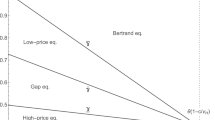Abstract
Shopbots are Internet agents that automatically search for information pertaining to price and quality goods and services. We study the impact on prices and price dispersion of such software agents. It is shown that price dispersion is a phenomenon which is independent of heterogeneity in E-tailers characteristics that is even if E-tailers provide the same service offerings, price dispersion remains whenever a captive market exists. Moreover, an increase in information does not reduce price dispersion but in general will increase it.
Similar content being viewed by others
References
Allen, B. and M. Hellwig. (1986). “Bertrand-Edgeworth Oligopoly in Large Markets.” Review of Economic Studies 53, 175–204.
Bailey, J.P. (1998). Electronic Commerce: Prices and Consumer Issues for three Products: Books, Compact Discs, and Software. OECD/GD (98)4.
Bakos, J.Y. (1997). “Reducing Buyer Search Costs: Implication for Electronic Marketplaces.” Management Science, 43(4), 563–585.
Bertrand, J. (1883). “Théorie Mathématique de la Richesse Sociale.” Journal des Savants 67, 499–508.
Biswas D. (2002). “Economics of Information in the Web Economy Towards a new Theory?” Journal of Business Research 5747, 1–10.
Brynjolfsson, E. and M.S. Smith. (2000). “Frictionless Commerce? A Comparison of Internet and Conventional Retailers.” Management Science 46(4), 563–585.
Brynjolfsson, E. and M.D. Smith. (2000). The great Equalizer? Consumer Choice Behavior at Internet Shopbots. MIT Sloan School of Management, Cambridge.
Darmon, E. and R. Waldeck. (2005a). “Convergence of Reinforcement Learning to Nash Equilibrium: A Search-Market Experiment.” Physica A (forthcoming).
Darmon, E. and R. Waldeck. (2005b). “Does it Matter to Play Nash: The Case of Adaptive Sellers? Working Paper downloadable at http://e.darmon.free.fr/in/fssmarket/paperfss.pdf.
Diamond, P.A. (1971). “A Model of Price Adjustment.” Journal of Economic Theory 3, 156–168.
Edgeworth, F.Y. (1925). “The Pure Theory of Monopoly.” In Edgeworth, Papers Relating to Political Economy. New York Burt Franklin, Vol. 1, pp. 111–142.
Kephart, J.O. and A.R. Greenwald. (1999). “Shopbot Economics.” In Proceedings of Fifth European Conference on Symbolic and Quantitative Approach to Reasoning with Uncertainty, pp. 208–220.
Larribeau, S. and et T. Penard. (2001). Commerce électronique et dynamique des prix: une applicationà la vente en ligne de CD. Mimeo.
Nelson, P. (1970). “Information and Consumer Behavior.” Journal of Political Economy 78.
Pan, X., T.B. Ratchford, and V. Shankar. (2001). Why Aren't the Prices of the Same Item the Same at Me.com and You.com?: Drivers of Price Dispersion Among E-Tailer. At http://bmgt1-notes.umd.edu/faculty/km/papers.nsf/.
Pan, X., T.B. Ratchford, and V. Shankar. (2002). Can Price Dispersion in Online Markets be explained by Differences in e-Tailer Service Quality? At http://bmgt1-notes.umd.edu/faculty/km/papers.nsf/.
Rosenthal, R.W. (1980). “A model in which the Increase in the Number of Sellers leads to a Higher Price.” Econometrica 48, 1575–1579.
Rothschild, M. (1973). “Models of Market Organization with Imperfect Information: A Survey.” Journal of Political Economy 81.
Salop, S. and J.E. Stiglitz. (1977). “Bargains and Ripoffs: A Model of Monopolistically Competitive Price Dispersion.” Review of economic studies 44, 493–510.
Satterthwaite, M.A. (1979). “Consumer Information, Equilibrium Industry Price, and the Number of Sellers.” The Bell Journal of Economics 10, 483–502.
Smith, M.D., J. Bailey, and E. Brynjolfsson. (1999). “Understanding Digital Markets: Review and Assessment.” In Erik Brynjolfsson and Brian Kahin (eds.), Understanding The Digital Economy. MIT Press.
Stahl, D.O. (1989). “Oligopolistic Pricing with Sequential Consumer Search.” American Economic Review 79, 700–712.
Stigler, G.J. (1961). “The Economics of Information.” Journal of Political Economy 69.
Stiglitz, J.E. (1987). “Competition and the Number of Sellers in a Market: Are Duopolies more Competitive than Atomistic Markets?” Journal of Political Economy 95, 1041–1046.
Varian, H. (1980). “A Theory of Sales.” American Economic Review 70, 651–659.
Vives, X. (1986). “Rationing Rules and Bertrand-Edgeworth Equilibria in Large Markets.” Economics Letters 21, 113–116.
Waldeck, R. (2002). “Rationing Rule, Imperfect Information and Equilibrium.” Economic Theory 19, 493–507.
Waldeck, R. (2001). “Imperfect Information and Bertrand-Edgeworth Equilibria.” Working paper http://www-eco.enst-bretagne.fr/Recherche/Biblio/Roger/imperfect%20information.pdf.
Waldeck, R. (2003). “Search and Price Competition.” Working paper. Forthcoming in Journal of Economic Behavior and Organization.
Whinston, A.B., D.O. Stahl, and C. Soon-Yong. (1997). The Economics of Electronic Commerce. Indianapolis, IN: Macmillan Technical Publishing.
Author information
Authors and Affiliations
Corresponding author
Rights and permissions
About this article
Cite this article
Waldeck, R. Prices in a Shopbot Market. Electron Commerce Res 5, 367–381 (2005). https://doi.org/10.1007/s10660-005-1179-1
Issue Date:
DOI: https://doi.org/10.1007/s10660-005-1179-1




